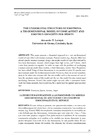Please use this identifier to cite or link to this item:
https://accedacris.ulpgc.es/jspui/handle/10553/7857
| Title: | The underlying structure of emotions: a tri-dimensional model of core affect and emotion concepts for sports | Authors: | Latinjak, Alexander T. | UNESCO Clasification: | 61 Psicología | Keywords: | Emotions Sports Anxiety Anger Emociones, et al |
Issue Date: | 2012 | Journal: | Revista Iberoamericana de Psicologia del Ejercicio y el Deporte | Abstract: | This paper presents a theoretical approach to a new tri-dimensional model of core affect and emotion concepts. Former models (e.g., Russell, 1980) have placed specific emotion concepts along a circumplex model of core affect defined by two basic dimensions: Arousal, which ranges from high to low, and Valence, which varies from positive to negative. In order to cope with the problem of overlapping emotion concepts inside these models, a third dimension, namely Time Perspective, has been added. Using all three dimensions, it was possible to place 20 specific emotion concepts inside the tri-dimensional model. However, there are several considerations to be taken into account with this new model, such as the essence of core affect, the simplistic nature of the model and the way this model fits into current sport psychology literature. Overall, this model might not only offer a conceptual framework for future research, but it could also be a useful tool for applied sport psychology. En este trabajo se presenta una aproximación teórica a un nuevo modelo tridimensional del afecto base y de los conceptos emocionales. Los modelos anteriores (e.g., Russell, 1980) han emplazado conceptos emocionales en un modelo circular definido por dos dimensiones: Activación, que varía entre alta y baja, y Valor, que varía entre positivo y negativo. Para poder resolver el problema de los conceptos emocionales solapados en el modelo, se ha añadido una tercera dimensión: la perspectiva temporal. Con ayuda de las tres dimensiones, ha sido posible ubicar 20 conceptos emocionales dentro del modelo. No obstante, hay diversas consideraciones acerca de este nuevo modelo que se han de tener en cuenta, como es la esencia del afecto base, la naturaleza simple del modelo y el lugar que ocupa en la literatura de la psicología del deporte. Todo en todo, este modelo podría no sólo aportar un marco conceptual para futuras investigaciones, sino que podría también ser una herramienta útil para la psicología aplicada del deporte. |
URI: | https://accedacris.ulpgc.es/handle/10553/7857 | Source: | Revista Iberoamericana de Psicología del Ejercicio y el Deporte. Sevilla : Wanceulen, 2006- .-- ISSN 1886-8576. año 2012, vol. 7, n. 1 |
| Appears in Collections: | Rev. Iberoam. psicol. ejerc. deporte. 2012. v.7, n.1 Artículos |
Page view(s)
203
checked on Sep 27, 2025
Download(s)
230
checked on Sep 27, 2025
Google ScholarTM
Check
Share
Export metadata
Items in accedaCRIS are protected by copyright, with all rights reserved, unless otherwise indicated.
